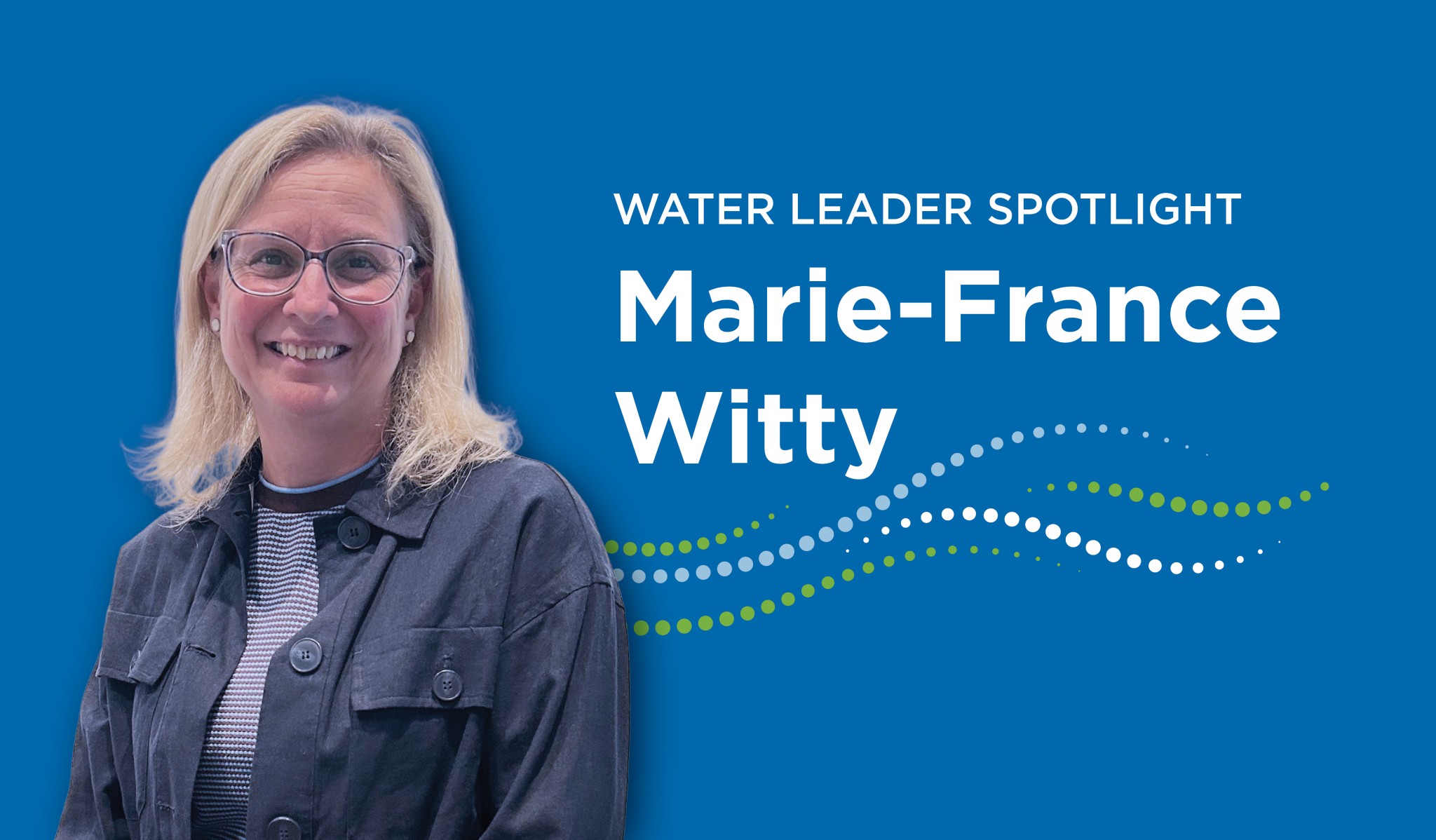Thought leader interview – Jimmy Zammar, City of Vancouver
June 12, 2023
CWN’s quarterly newsletter with the latest news, insights and thought leadership.

This edition’s thought leader interview features Jimmy Zammar, the City of Vancouver’s director of urban watersheds, sewers and drainage, who shares his experience in implementing the city’s Rain City Strategy.
How did the City of Vancouver’s Rain City Strategy come about?
The Rain City strategy is the fruit of over 10 years of effort by city staff from across departments, and elevates work by grassroots community groups and the local First Nations. It is the fulfillment of our provincial requirement, similar to other cities, to develop an updated integrated rainwater management plan for the city.
The strategy is also the culmination of a journey of transformation within the city to establish new capabilities that go beyond the actual strategy with its vision, goals, objectives and action plans. These foundational capabilities include introducing:
- New skillsets, such as planners and landscape architects, to the sewers and drainage business.
- Expanded investments and skillsets in sewer and drainage system monitoring and modelling.
- New financial tools and enabling policies like requirements for building-scale rainwater management solutions and the utility development cost levy. This levy makes it possible for “growth to fund growth.”
The confluence of these efforts has allowed us to think big.
The new approach to rainwater as a valued resource relies on integrating infrastructure planning, land-use planning and urban design approaches into the management of the urban water cycle. How is this done in practical terms? What has changed to allow for this?
In practical terms, we started by identifying cross-cutting Integrated Water Management (IWM) issues. We found that the list was long and included over 30 initiatives that impacted multiple departments in the city. To help convey the breadth and complexity of these issues, we adopted the term “One Water.”
This list of issues and the associated One Water branding helped us highlight the fact that urban water challenges are shared problems that require shared solutions. So, we created a One Water Steering Committee comprised of general managers from all relevant departments within the City of Vancouver and the Vancouver Board of Parks and Recreation. This committee allowed us to elevate visibility most of these issues were not exclusively engineering problems, but city-wide resilience, affordability and livability problems. This steering committee was really helpful in achieving executive support and was backed up by a One Water Directors forum with those directors who reported to the general managers.
In terms of process, the keyword is collaboration. In the past, utility servicing was seen as an afterthought that provided “plumbing” to service a development area. We have advanced in our collaboration to a point where urban water management is seen as a foundational building block of growth planning, and a key enabler of innovative and cost-effective solutions to housing and economic growth in the city. Today, the One Water team of engineers and watershed planners work in lockstep with other departments, notably the city’s Planning, Urban Design, and Sustainability Department on urban development projects from day one.
The Rain City Strategy mandated that stormwater volumes and runoff water quality must be managed both within the public right-of-way and within buildings.
In the building space, this has led to changes in how building stormwater systems are conceived and how they perform. More than 110 development applications for complex buildings have been completed since the new requirements were enacted, which have led to approximately 46 hectares of total site area runoff being “managed” for runoff quality and volume. The cumulative reduction from these sites in design storm peak flow reaching city sewer systems is approximately 4500 L/s, and the cumulative volume managed exceeds 10,000 m3.
In the street right-of-way, we have transformed our approach to utility service delivery and expanded our toolkit of infrastructure solutions to meet the Rain City Strategy goals alongside our other tools and commitments such as sewer separation. The current capital plan includes a 200% increase in investments in green rainwater infrastructure and to date, we have built and are maintaining 65 new assets in the street right-of-way. These assets bring measurement improvements to drainage while advancing livability, environmental goals, climate resilience and biodiversity.
What tools do you use to assess water risk in a growth area?
If we had the resources, we would start with a comprehensive city-wide modelling and monitoring effort to accurately determine sewers and drainage risks and levels of service within the system. This would incorporate additional climate risks such as sea level rise. Unfortunately, we don’t have the luxury of being able to pause and undertake this comprehensive planning city-wide all at once.
To address this need, we have launched the Healthy Waters Plan initiative to undertake system-level planning to inform broad decision-making around sewers and drainage services and outcomes. This plan will also guide our investment and policies at watershed level in the coming decades.
Concurrently, we are leveraging areas where we are facing growth to instigate an “integrated planning” effort that leverages policy and investments in green and grey infrastructure to achieve our goals. We start by mobilizing a multi-disciplinary team that includes planners, engineers and landscape architects to undertake a current state assessment, implement monitoring, and develop a calibrated model to determine our current and future system performance. We validate our findings by observing real-world system performance and checking against customer sewer back-up and flooding complaints. Based on this set of data, we undertake an options analysis to determine the most cost-effective approach to mitigate risk, provide new capacity to service growth, and achieve multiple benefits.
The process may sound easier than it actually is. We are facing multiple imperatives, and our decision-making must try to balance affordability, risk mitigation, and achieving incremental outcomes. Some of our imperatives include growth pressures, climate risks (we use intensity-duration frequency curves for the year 2100), a legacy combined sewer system and its combined sewer overflow (CSO) problems, runoff pollution and its impacts to the environment, and aging infrastructure. We don’t want to solve one problem at the expense of another. For example, we don’t want to grow at the expense of increasing CSOs. Using a collaborative and iterative approach, and working with our partners internally and across jurisdictions, we develop a suitable servicing strategy for each growth area, while maintaining consistency across the city and building on our learnings.
Currently, about 60 percent of the city is modelled for pipe system performance, up from less than 10 percent five years ago. By the end of the decade, we are aiming to have a city-wide model supported by real-time monitoring of our pipe system.
A recent example of our integrated, One Water approach to growth is the Broadway Area plan. The One Water strategy for the Broadway Area plan aims to address the utility servicing needs to accommodate tens of thousands of new residents and workers while addressing water quality issues and climate risks. The plan was triggered by the extension of the regional SkyTrain network into the area.
To service the area, we started identifying the four watersheds that this area plan impacts and took into account how each watershed functions. The end result is an innovative investment strategy for the pipe network. We’ve also reimagined how our buildings and streets can create spaces for water to be captured and treated while providing other essential services such as multi-modal transportation (walking, cycling, rolling), the creation of gathering spaces and bolstering the biodiversity and tree cover in the city.
We adopt a hierarchy of rainwater management tools, with the top priority being holding back rainwater closer to where it falls through infiltration into the ground or evaporation into the air. Then we try to use green infrastructure or equivalent solutions to hold-back or slow-down flows, and capture pollutants. Lastly, we design our pipe system upgrades and overland infrastructure (e.g. roads) for safe conveyance. The objective is to minimize the amount of rainwater conveyed through pipes to maximize local benefits and defer costly and complex upgrades where possible.
By applying this hierarchy, we are envisioning and creating a transformed and resilient city, with distributed green infrastructure and a revived street right-of-way, connected by a multifunctional blue-green network.
What design standard does the strategy apply?
The strategy reaffirms the previously adopted performance target to “manage” 90 percent of Vancouver’s average annual rainfall. By “manage,” we mean infiltrate, evapo-transpirate, and/or reuse, and treat for pollutants.
As well, the strategy improves the design standard for the volume of rainwater to be managed by green rainwater infrastructure assets to 48 mm per day. The design standard is applied to every public green rainwater infrastructure project, site or district-scale asset.
The long-term goal is to manage urban rainwater runoff from 40 percent of the impervious area in the city by 2050 using green rainwater infrastructure.
In 2016, we created a dedicated green infrastructure implementation branch. Prior to that, we had very limited in-house capabilities for such typologies of assets. The branch is now 30 people strong and houses one of the most talented green infrastructure teams in Canada.
Every asset we build today meets our standard and follows our asset lifecycle management approach. Assets are inspected and monitored frequently using monitoring wells, data loggers and other tailored tools. Our asset performance database shows that these assets are performing at the expected performance level, and in many cases, substantially exceeding their performance levels.
As a coastal city, how do you factor in sea rise?
We factor in sea level rise in all projects that entail a coastal component. As sea level rise progresses, and our modelling allows us to visualize its impacts, we are leveraging data and real-life example to educate our community about what the future may look like. We are also working together to reimagine how to adapt to this new reality.
One project recently completed that showcases our approach is the Sea2City Design Challenge, which has just received the silver award from the Planning Institute of BC (PIBC) in the category of “awards for Excellence in Planning Practice – City & Urban Areas.” We chose four sites around False Creek that will be subject to serious flooding due to sea level rise and pluvial hazards.
We hired two consortia of firms to help us collaboratively reimagine a coastline that is more adaptive with deep First Nations and community engagement. Not everyone is aware of how climate risk will materialize, so this project served as an important opportunity to bring the community along while exploring what a decolonized shoreline would look like, what our climate future will look like and where water will go. New York City and San Francisco have undertaken similar exercises.
What type of green rain infrastructure (GRI) and water recycling/reuse projects have you implemented under the RainCity Strategy?
To date, the city has implemented over 230 GRI assets in streets and public spaces. The assets include bioretention practices, permeable pavement areas, subsurface infiltration trenches and soak ways, rainwater tree trenches and engineered wetlands. By far, the biggest asset category is bioretention, which makes up over half of all GRI assets in Vancouver.
We have about 40 registered non-potable water systems installed. This requires considerable negotiation with developers, building maintenance and property managers with the required knowledge and expertise. It also requires monitoring and annual inspections, and a strong business case.
These non-potable water systems were authorized under the City of Vancouver’s own building bylaw, which goes beyond the provincial building code. Vancouver has this authority by virtue of its charter city status. The Vancouver building code allows for alternative water sources for certain non-potable uses. It has facilitated buildings of various sizes, including office towers, to connect to reuse systems using rainwater and groundwater for use in irrigation, toilets, car washes and cooling systems.
The largest application is in Oakridge Town Centre, a large development that happens to also be tapped into the groundwater table due to historical circumstances. It is using groundwater and rainwater to offset the use of drinking water. This has resulted in multiple benefits, including mitigating CSOs and reducing demand on drinking water supply.
The city works hand in hand with the development and building industry to ensure that developers, engineers, architects, builders and operators have the skills and capacity to maintain these systems. While we have accomplished a lot, we are still in the early days of this innovative journey.
How has the City of Vancouver addressed equity issues in the Rain City Strategy?
That’s a huge question. Let me start with a very high-level answer. We know that not everyone is equally impacted by the hazards of climate change and environmental pollution. These hazards disproportionately impact systemically underserved or marginalized communities, notably those facing other barriers, including discrimination, lack of secure housing and low income.
An intersectional lens is key to understanding these issues. Solutions should be trauma-informed and must include full community participation. We use the city’s Equity Framework in guiding our work.
Some of the major issues we pay attention to are the risks of too much water during the rainy season, and too little water during the drier season. We have seen how these risks hit communities in inequitable ways. The 2022 BC coroner’s report, which followed the 2021 summer heat wave in BC, mapped out some of the underlying reasons for this vulnerability that led to over 600 deaths due to excessive heat exposure. The coroner identified that this was in part due to the urban heat island effect. Tree canopy is inequitably distributed around the city, and its presence is correlated with income. Vancouver’s downtown east side has a lower-income population, lacks adequate tree cover, and has fewer places for folks to seek shelter from the heat. As such, the city is directing considerable funds and services to support this area.
There is also a relationship between equitable One Water services, and achieving reconciliation with the local First Nations, as demonstrated in the city’s UNDRIP strategy developed in partnership with Musqueam Indian Band, Squamish Nation and Tsleil-Waututh Nation. For example, CSOs impact the aquatic environment in certain parts of the city more than others, and compound barriers that the local First Nations face to access clean marine and freshwater sites for cultural purposes.
What cities did the City of Vancouver use for inspiration with regard to its Rain City Strategy?
We were impressed with what Rotterdam has done through its Climate Proof Programme, and with Amsterdam’s Rainproof program. In North America, New York City has invested $1 billion in over 10,000 green infrastructure projects over the last 15 years. In Portland, Oregon, its five-year Grey to Green infrastructure program brought city departments together to coordinate green infrastructure projects. Finally, in 2011, the City of Philadelphia adopted a 25-year plan, the Green City Clean Waters program, to reduce stormwater entering the city’s combined sewer system using a mix of green infrastructure and traditional stormwater infrastructure upgrades.
Can you share some reflections on how your work on Vancouver’s Rain City Strategy fits into your career and your values?
My career has always straddled multiple disciplines in the infrastructure, resilience and sustainability space, with collaboration and empowerment as core values at its centre.
Collaboration is honestly the secret sauce to achieving lasting impacts in complex jurisdictions. Any advancement that does not achieve deep buy-in is bound to be unwound with time. The work to develop the Rain City Strategy, and importantly to sustain and advance its implementation, is a true demonstration of this value.
Empowerment is key to enabling the creative potential of a team. It is humbling to see how it leads to the team’s potential being larger than the sum of its parts. Our teams are diverse and leverage that diversity to build unique strengths and creative potential.
Our work is addressing a basic human right, urgent imperatives, and is trying to resolve chronic problems that are centuries in the making, and I am so humbled to be doing this work within the city of Vancouver.












